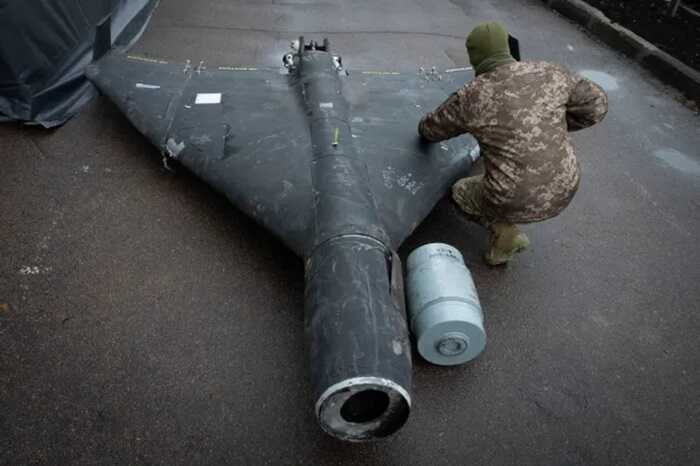
Russia has been quietly churning out hundreds of thermobaric drones which can collapse lungs, crush eyeballs and cause brain damage in its war on Ukraine.
Also known as vacuum bombs, they suck out all the oxygen in their path, creating a vortex of high pressure and heat that can penetrate thick walls and inflict injuries far beyond the blast site.
From a military point of view, the warheads are ideal for hitting targets that are either inside fortified buildings or deep underground.
They are particularly destructive when they strike buildings, because they are loaded with ball bearings to cause maximum damage, David Albright, of the Washington-based Institute for Science and International Security, said.

The Iranian-designed drones have already wreaked havoc across Ukraine since being deployed in 2022 (Credits: Ukrainian Emergency Service via AP)
Serhii Beskrestnov, a Ukrainian electronics expert, said the drones were first used over the summer and estimated that they now make up between 3% and 5% of all drones.
Mr Beskrestnov told the Associated Press: ‘This type of warhead has the possibility to destroy a huge building, especially block flats.
‘And it’s very effective if the Russian Federation tries to attack our power plants.’
They have a fearsome reputation because of the physical effects even on people caught outside the initial blast site, said Arthur van Coller, an expert in international humanitarian law at South Africa’s University of Fort Hare.

Serhii Beskrestnov, a Ukrainian electronics expert, said the drones can ‘destroy a huge building’ (Credit: AP Photo/Hanna Arhirova)
‘With a thermobaric explosion, because of the cloud it would create, everything in its radius would be affected,’ he said.
‘It creates massive fear in the civilian population. Thermobaric weapons have created this idea that they are really horrible weapons and that creates fear.’
They are being built alongside hundreds of decoy drones meant to overwhelm Ukrainian defences, an Associated Press investigation has found.
Russia came up with the plan for decoys in late 2022 and codenamed it Operation False Target, according to a person familiar with Russia’s drone production who spoke on condition of anonymity.

There are fears that the drones could injure or kill civilians if they end up hitting residential areas (Credits: AP/Alex Babenko)
The idea was to launch armed drones along with dozens of decoys, sometimes stuffed with rags or foam, and indistinguishable on radar from those carrying real bombs.
Ukrainian forces must then make split-second decisions about how to expend scarce resources to save lives and preserve critical infrastructure.
‘The idea was to make a drone which would create a feeling of complete uncertainty for the enemy,’ the source said.
‘So he doesn’t know whether it’s really a deadly weapon … or essentially a foam toy.’

Decoy drones are being used to try and overwhelm Ukraine’s air defences before the armed ones are deployed (Credits: Valentyn Ogirenko/REUTERS)
And with the thermobarics, there is now a ‘huge risk’ an armed drone could deviate from its course and end up in a residential area where the ‘damage will be simply terrifying’, he said.
In recent weeks, decoys have filled Ukraine’s skies by the dozens, each one appearing as an indistinguishable blip on military radar screens.
During the first weekend of November, the Kyiv region spent 20 hours under air alert, and the sound of buzzing drones mingled with the boom of air defences and rifle shots.
Unarmed decoys now make up more than half the drones targeting Ukraine, according to the person and Mr Beskrestnov.

The drones are being built in Russia after Vladmir Putin signed a £1.35bn deal with Iran in 2022 (Credits: AP Photo/Efrem Lukatsky)
The unarmed decoys and the armed Iranian-designed Shahed drones are being built at a factory in Russia’s Alabuga Special Economic Zone, an industrial complex set up in 2006 about 600 miles east of Moscow to attract businesses and investment to Tatarstan.
It expanded after the 2022 invasion of Ukraine and some sectors switched to military production, adding new buildings and renovating existing sites, according to satellite images analysed by The Associated Press.
In social media videos, the factory promotes itself as an innovation hub. But Mr Albright said Alabuga’s current purpose is purely to produce and sell drones to Russia‘s Ministry of Defence.
Russia and Iran signed a £1.35 billion deal for the Shaheds in 2022, after Russian president Vladimir Putin invaded Ukraine, and Moscow began using Iranian drones in battle later that year.
Soon after the deal was signed, production started in Alabuga.
In October, Moscow attacked with at least 1,889 drones – 80% more than in August, according to an AP analysis tracking the drones for months.
On Saturday, Russia launched 145 drones across Ukraine, just days after the re-election of Donald Trump threw into doubt US support for the country.
Read more similar news:
Comments:
comments powered by Disqus

































